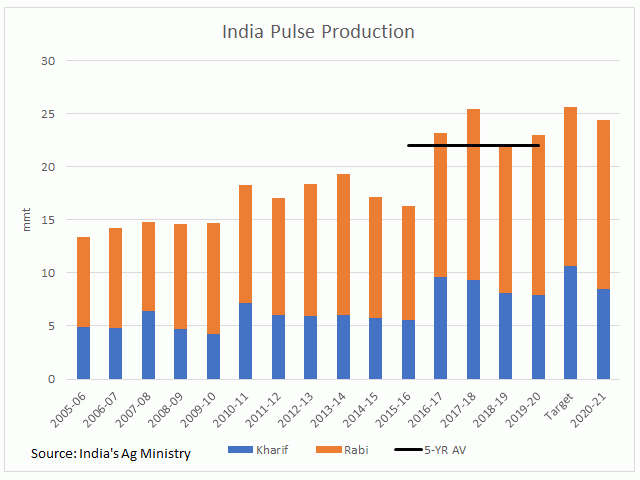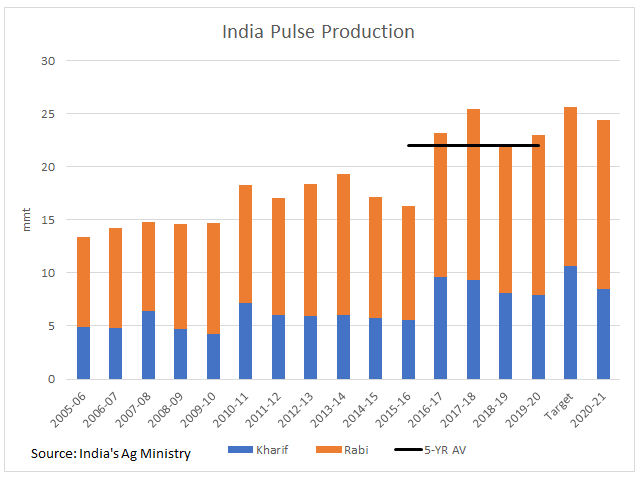Canada Markets
India Updates 2020-21 Pulse Crop Estimates
India's government has estimated the production of all foodgrains at a record 303.34 million metric tons, above the estimated 297.5 mmt produced in 2019-20 and the current crop year target of 301 mmt.
The government's Second Advance Estimates of Production of Foodgrains for 2020-21 data shows total pulse production for 2020-21 estimated at 24.42 mmt, up from 23.03 mmt produced in 2019-20, the five-year average of 21.992 mmt, but below the initial target for a record 25.6 mmt.
P[L1] D[0x0] M[300x250] OOP[F] ADUNIT[] T[]
During the past five years, actual production came in lower than the target production in three of the five years according to government statistics, with final production ranging from 2.3 mmt higher than the initial target to 3.6 mmt lower than target. Actual production fell below the target volume in each of the past two years, with production down 3.2 mmt from target in 2019-20 and down 2.6 mmt in 2018-19, while averaging 1 mmt lower during the five years.
During the past five years, in the three years where production fell short of the government's target volume, production fell short of target in both the kharif (summer monsoon season crop) as well as the rabi or winter crop, although 2020-21 estimates are forecast to break this trend. Estimates for 2020-21 shows kharif production is forecast to fall 2.14 mmt below its initial target while rabi production is forecast to be almost 1 mmt above its initial target at 15.96 mmt, which would be the second-largest winter crop next to the record 16.11 mmt production for the 2017-18 winter crop.
It is also interesting to note that during the past five years, the drop in forecast production for the rabi crop averaged roughly 0.8 mmt relative to the initial target, which is higher than the 0.5-mmt average drop calculated for the smaller kharif crop. Data just released for 2020-21 shows a 2.14 mmt drop in kharif production from the original targeted volume, while winter or rabi production is forecast to be 0.96 mmt above target.
The government's All India Weather Summary and Forecast Bulletin as of Feb. 26 shows northern and eastern areas of the country largely dry during the Jan. 1-through-Feb. 24 period, with precipitation averaging 30% below normal. Of the 36 subdivisions of the country reported, two are viewed as normal, while 13 are viewed as having received excessive amounts of rain, mostly along the western side of the country. A reported 21 of the regions are shown to range from having deficient precipitation (seven in total) to a large precipitation deficiency (13 in total) to no rain at all (one region).
Cliff Jamieson can be reached at cliff.jamieson@dtn.com
Follow him on Twitter @Cliff Jamieson
(c) Copyright 2021 DTN, LLC. All rights reserved.






Comments
To comment, please Log In or Join our Community .